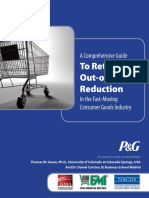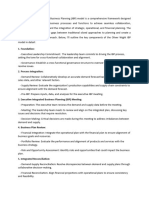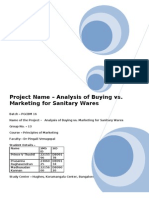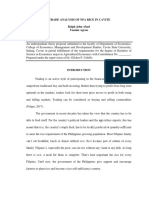0 ratings0% found this document useful (0 votes)
338 viewsAnalyzing Out-Of-stock in Independent Grocery Stores. An Empirical Study
Analyzing Out-Of-stock in Independent Grocery Stores. An Empirical Study
Uploaded by
LenutaGiscaThis document summarizes a study that analyzed out-of-stock (OOS) situations in independent grocery stores in Denmark. The study had two parts: 1) A quantitative comparison of OOS rates and root causes between independent grocery stores and centrally-organized chain stores, finding that independent stores had significantly higher OOS rates and more categories affected. 2) Qualitative interviews with independent store managers that identified store management practices influencing OOS, such as ordering processes, staff stability, and inventory planning. The findings provide insights into reducing OOS in the independent grocery sector.
Copyright:
© All Rights Reserved
Available Formats
Download as PDF, TXT or read online from Scribd
Analyzing Out-Of-stock in Independent Grocery Stores. An Empirical Study
Analyzing Out-Of-stock in Independent Grocery Stores. An Empirical Study
Uploaded by
LenutaGisca0 ratings0% found this document useful (0 votes)
338 views26 pagesThis document summarizes a study that analyzed out-of-stock (OOS) situations in independent grocery stores in Denmark. The study had two parts: 1) A quantitative comparison of OOS rates and root causes between independent grocery stores and centrally-organized chain stores, finding that independent stores had significantly higher OOS rates and more categories affected. 2) Qualitative interviews with independent store managers that identified store management practices influencing OOS, such as ordering processes, staff stability, and inventory planning. The findings provide insights into reducing OOS in the independent grocery sector.
Original Title
Analyzing Out-Of-stock in Independent Grocery Stores. an Empirical Study
Copyright
© © All Rights Reserved
Available Formats
PDF, TXT or read online from Scribd
Share this document
Did you find this document useful?
Is this content inappropriate?
This document summarizes a study that analyzed out-of-stock (OOS) situations in independent grocery stores in Denmark. The study had two parts: 1) A quantitative comparison of OOS rates and root causes between independent grocery stores and centrally-organized chain stores, finding that independent stores had significantly higher OOS rates and more categories affected. 2) Qualitative interviews with independent store managers that identified store management practices influencing OOS, such as ordering processes, staff stability, and inventory planning. The findings provide insights into reducing OOS in the independent grocery sector.
Copyright:
© All Rights Reserved
Available Formats
Download as PDF, TXT or read online from Scribd
Download as pdf or txt
0 ratings0% found this document useful (0 votes)
338 views26 pagesAnalyzing Out-Of-stock in Independent Grocery Stores. An Empirical Study
Analyzing Out-Of-stock in Independent Grocery Stores. An Empirical Study
Uploaded by
LenutaGiscaThis document summarizes a study that analyzed out-of-stock (OOS) situations in independent grocery stores in Denmark. The study had two parts: 1) A quantitative comparison of OOS rates and root causes between independent grocery stores and centrally-organized chain stores, finding that independent stores had significantly higher OOS rates and more categories affected. 2) Qualitative interviews with independent store managers that identified store management practices influencing OOS, such as ordering processes, staff stability, and inventory planning. The findings provide insights into reducing OOS in the independent grocery sector.
Copyright:
© All Rights Reserved
Available Formats
Download as PDF, TXT or read online from Scribd
Download as pdf or txt
You are on page 1of 26
International Journal of Retail & Distribution Management
Emerald Article: Analyzing out-of-stock in independent grocery stores: an
empirical study
Jesper Aastrup, Herbert Kotzab
Article information:
To cite this document: Jesper Aastrup, Herbert Kotzab, (2009),"Analyzing out-of-stock in independent grocery stores: an empirical
study", International Journal of Retail & Distribution Management, Vol. 37 Iss: 9 pp. 765 - 789
Permanent link to this document:
http://dx.doi.org/10.1108/09590550910975817
Downloaded on: 07-02-2013
References: This document contains references to 31 other documents
Citations: This document has been cited by 2 other documents
To copy this document: permissions@emeraldinsight.com
This document has been downloaded 1393 times since 2009. *
Users who downloaded this Article also downloaded: *
Jesper Aastrup, Herbert Kotzab, (2009),"Analyzing out-of-stock in independent grocery stores: an empirical study", International
Journal of Retail & Distribution Management, Vol. 37 Iss: 9 pp. 765 - 789
http://dx.doi.org/10.1108/09590550910975817
Jesper Aastrup, Herbert Kotzab, (2009),"Analyzing out-of-stock in independent grocery stores: an empirical study", International
Journal of Retail & Distribution Management, Vol. 37 Iss: 9 pp. 765 - 789
http://dx.doi.org/10.1108/09590550910975817
Jesper Aastrup, Herbert Kotzab, (2009),"Analyzing out-of-stock in independent grocery stores: an empirical study", International
Journal of Retail & Distribution Management, Vol. 37 Iss: 9 pp. 765 - 789
http://dx.doi.org/10.1108/09590550910975817
Access to this document was granted through an Emerald subscription provided by BCU BUCURESTI
For Authors:
If you would like to write for this, or any other Emerald publication, then please use our Emerald for Authors service.
Information about how to choose which publication to write for and submission guidelines are available for all. Please visit
www.emeraldinsight.com/authors for more information.
About Emerald www.emeraldinsight.com
With over forty years' experience, Emerald Group Publishing is a leading independent publisher of global research with impact in
business, society, public policy and education. In total, Emerald publishes over 275 journals and more than 130 book series, as
well as an extensive range of online products and services. Emerald is both COUNTER 3 and TRANSFER compliant. The organization is
a partner of the Committee on Publication Ethics (COPE) and also works with Portico and the LOCKSS initiative for digital archive
preservation.
*Related content and download information correct at time of download.
Analyzing out-of-stock
in independent grocery
stores: an empirical study
Jesper Aastrup
Department of Marketing, Copenhagen Business School,
Centre of Retail Studies, Frederiksberg, Denmark, and
Herbert Kotzab
Supply Chain Management Group, Department of Operations Management,
Copenhagen Business School, Frederiksberg, Denmark
Abstract
Purpose The purpose of this paper is to examine out-of-stock (OOS) challenges in the independent
grocery sector with a special emphasis on in-store root causes. The analysis aims to assess the extent
and root causes for OOS in the independently controlled retail sector and provide a comparison of
these results with the centrally controlled chain sector in Denmark. The paper also seeks to examine
the practices and challenges of store ordering and store replenishment processes in the independent
sector and identify practical implications for store management and other members of the grocery
channels.
Design/methodology/approach The research design includes two studies. Study-I surveys and
compares the extent and root causes of OOS of 42 stores from eight chains in the two sectors. Study-II
identies, based on qualitative interviews with 17 store managers/owners of independent stores,
specic insights on store operations.
Findings The quantitative study shows that the OOS rates in the independent sector are
signicantly higher than in the centrally organized sector. Furthermore, the independent grocery
sector faces OOS challenges in more categories than the centrally controlled sector. The study also
reveals a very large variation in the performance of independent stores. Contrary to the centrally
controlled chain store sector, the major root cause for OOS in the independent sector is found in the
store ordering process. The qualitative study shows that the main discriminating issues between
stores with a low and a high OOS rate are: store management emphasis and commitment to OOS
issues; the resulting priority and managerial guidance in store ordering and store replenishment tasks;
the stability of staff and the proper planning for replenishment peaks; the store size and resulting
space conditions; and the use of appropriate decision heuristics and use of inventory in store ordering.
Practical implications The ndings have practical implications for store management as it
reveals practices to pursue and to avoid. Also, it is argued that the ndings have implications for the
other members of the grocery channels.
Originality/value Empirically, this paper explores two issues not being dealt with in depth in
previous research, i.e. the OOS challenge in the independent sector and the emphasis on store
operations.
Keywords Stock control, Shelf space, Retail trade, Denmark
Paper type Research paper
1. Introduction
Product availability, dened as the probability of having a product in stock when a
customer order arrives (Chopra and Meindl, 2007, p. 77), is one of the key performance
The current issue and full text archive of this journal is available at
www.emeraldinsight.com/0959-0552.htm
OOS in
independent
grocery stores
765
Received August 2008
Revised December 2008
Accepted December 2008
International Journal of Retail &
Distribution Management
Vol. 37 No. 9, 2009
pp. 765-789
qEmerald Group Publishing Limited
0959-0552
DOI 10.1108/09590550910975817
components of customer service. The complement to product availability is
out-of-stock (OOS) which can be dened as: a product not found in the desired
form, avour or size, not found in saleable condition, or not shelved in the expected
location (Efcient Consumer Response ECR Europe, 2003). European grocery
shoppers rate OOS as the third most important issue after shorter queues and more
promotions (ECR Europe, 2003). When facing an OOS, shoppers show different
reactions ranging from switching store, brand or variant or to delaying or to even
dropping the purchase (Kucuk, 2008). The consequences of OOS are loss in sales and
shoppers for retailers as well as for manufacturers (Corsten and Gruen, 2003). Every
year, the European grocery industry loses approx. e400 billion due to OOS (ECR
Europe, 2003). The successful management of product availability by reducing OOS
rates therefore represents a potential driver for increasing revenues (Corsten and
Gruen, 2003).
OOS has been studied so far from two broad angles. One research stream has
focused on the customer reactions to an OOS situation, representing consumer
behavior. The second stream looks at the extent and root cause analysis of OOS
situations and represents the logistics/supply chain operations perspective. Here,
research shows that 70-90 percent of OOS situations originate from causes at store
level (Corsten and Gruen, 2003; ECR Europe, 2003). Hence, a deterioration of
availability seems to be a fact in todays grocery supply chains, from suppliers over
central warehouses to the grocery supply chains ultimate service level on the shelf.
This paper contributes to the second stream of OOS-research with an emphasis on
the in-store operational causes as part of the logistics processes in independent grocery
stores in Denmark. This study is a result of a research cooperation between the
Copenhagen Business School and ECR Denmark where the particularities of the
independent sector in terms of product availability have been studied. Existing studies
have so far looked at OOS in centrally organized chain stores, so it would be interesting
to see whether the independent sector shows differences in this area. Therefore, our
study compares the Danish independent grocery sector with the centrally organized
chain sector and analyses in depth the store-related practices in the independent sector.
Consequently, we developed the following research questions:
RQ1. Is there a difference in the extent of OOS and its root causes between the
independent grocery stores and centrally organized grocery stores?
RQ2. Do the two sectors differ on the OOS variability across stores?
RQ3. What are the particular challenges and practices of the independent grocery
stores when it comes to the management of OOS?
Based on our analysis, we intend to suggest areas of managerial effort which can be
used to reduce the OOS in the independent grocery sector.
Our methodological approach is a two-stage research design combining a
quantitative examination of extent and root causes ( Study-I) with a qualitative
examination on store-related practices and their inuence on OOS situations
( Study-II). We compare the extent and root causes of OOS between centrally
organized and independent sector stores by applying the methodology, which has been
used in the majority of existing OOS studies (Gruen et al., 2002), by physically auditing
OOS situations in stores and tracking the root causes of these OOS situations afterwards
IJRDM
37,9
766
in administrative systems. These identied quantitative measures on extent and root
causes are then linked to a qualitative analysis of store-related root causes in the
independent sector. This will provide an in depth analysis of the relationship between
store operations and created OOS situations.
The paper is structured as follows. In Section 2, literature on OOS is reviewed.
Section 3 considers the methodological approaches and presents the Danish grocery
retail context from an independent sector point of view. In Sections 4 and 5, the results
of the empirical analysis is presented. This includes a comparison of the quantitative
extent and root causes in the independent and centrally controlled chain sector and an
elaboration on practices in independent stores based on qualitative interviews. The
paper closes with a critical summary, a discussion on the managerial implications for
store management, and an outlook for future research.
2. Literature and background
An OOS represents a situation where a product is not available when a customer order
arrives. Kucuk (2008) calls the OOS situation the intersection between consumer
behavior and distribution which has led to two different research streams since the late
1960s. Research stream-I can be labeled as consumer behaviouralist approach and
deals with consumers responses to OOS situations (Sloot et al., 2005; Kucuk, 2008).
Research stream-II can be labeled as logistics/supply chain operations approach and
addresses the logistics processes causing OOS situations (Corsten and Gruen, 2003;
Grant and Fernie, 2008).
Early work in Research stream-I identied different consumer responses to OOS
based on experimental research designs. The consumer responses to OOS have been
presented in the form of decision trees and range from substituting the intended
purchase with another size or switching brand or postponing the shopping action
(Walter and Grabner, 1975; Schary and Christopher, 1979; Emmelhainz et al., 1991b). In
their global study, Corsten and Gruen (2003) applied the ve responses of:
(1) buy item at another store;
(2) delay purchase;
(3) substitute same brand;
(4) substitute different brand; and
(5) do not purchase item.
The results of the Corsten and Gruen (2003) study showed that 31 percent of the
customers will buy the intended item at another store, while 15 percent delay the
purchase, 19 percent substitute within the brand, 26 percent substitute to another brand,
and 9 percent do not purchase the item. The same distinction has also been applied by
ECR Europe (2003) and by the Institute of Grocery Distribution (IGD) in the UK (IGD,
2004, 2005, 2006, 2007). There, the ECREurope (2003) study shows that 21 percent of the
customers buy the item at another store, 17 percent delay the purchase, 16 percent
substitute within the brand, 37 percent substitute to another brand, and 9 percent do not
purchase item. However, these responses differ considerably across categories
(Gruen et al., 2002; Kucuk, 2008). In general, impulse items, less involvement, more
substitutability and less brand loyalty increases the likelihood of substitution purchases
(other variant or brand), whereas strong brand loyalty, more planned purchases,
OOS in
independent
grocery stores
767
and higher involvement increases the likelihood of store switching (ECR Europe, 2003).
Adetailed overviewof these response patterns across different categories fromprevious
studies are given in Kucuk (2008). Nevertheless, the results showthat the majority of the
behavioural patterns represent a lost sale for the retail store and a lost sale for the brand
supplier.
Additional OOS research within Research stream-I looked at different consumer
behaviour issues underlying the response patterns. Emmelhainz et al. (1991a) studied
the effect of the perceived risk of switching to an alternative brand, the effect of urgency
of purchase and the effect of the use occasion. Verbeke et al. (1998) examined the effect of
the availability of competing stores, of whether OOS was a temporary or permanent
change in assortment, of store loyalty and of the size of the shopping trip. Fitzsimons
(2000) analysed consumers decision satisfaction in OOS situations as a result of the
commitment to the item OOS and the impact on decision difculty. Campo et al. (2000)
developed a model based on the consumer maximizing utility in terms of substitution
cost (decreased utility of item switching), transaction costs (search and transport costs)
and opportunity costs (cost of not consuming in the category). Their overall results,
which are in line with other literature, show that loyalty towards OOS item lowers the
probability of switching items, store loyalty and the availability of acceptable
alternatives on the other hand increases the likelihood of item switching. Campo et al.
(2003) extended the methodology to scanner panel data which allowed them to study
quantity effects, switching effects and post-OOS purchase effects. Kucuk (2004) studied
how in-store merchandising and store attractiveness factors affect consumers brand
and store loyalty in OOS situations. Sloot et al. (2005) analyzed the brand equity of the
item OOS as well as the hedonic element of the shopping purpose. Recently, Kucuk
(2008) examined double jeopardy patterns and showed how OOS rates, as part of the
broader construct of distribution effectiveness, affect consumer penetration as well as
consumer behavioural loyalty towards the brand.
In Research stream-II, the extent of OOS, the underlying logistical processes causing
OOS situations and different managerial measures on how to deal with OOS were
studied mainly in the grocery sector (Corsten and Gruen, 2003; ECR Europe, 2003;
Fernie and Grant, 2008). Most of these studies indicate average OOS rates across
categories in a range between 7 and 10 percent. Gruen et al. (2002) came up with a
global OOS average at 8.3 percent, where the Northern and Western European
countries performed slightly better with an average OOS rate at 7.2 percent. Similarly,
ECR Europe (2003) arrived at a 7.1 percent for European countries, while British
retailers showed an impressive 4 percent OOS rate (IGD, 2004, 2005, 2006, 2007).
The OOS-rate is caused by decient distribution, bullwhip effects and retail store
ineffectiveness (Kucuk, 2004, 2008; Corsten and Gruen, 2003; Fernie and Grant, 2008).
This is presented in more detail in the ECR Europe (2003) study which sees the
following logistics variables in relation to OOS:
.
Product availability deteriorates through the last metres. While typical service
levels between suppliers and central warehouses and from central warehouses to
the stores range between 97 and 99 percent, the shelf service level in the store is
around 92-93 percent. This indicates that a major part of the root causes can be
found in in-store operations.
.
The extent of OOS depends on the characteristics of the category. OOS rates
clearly vary between categories, with the worst performing at about 15-16
IJRDM
37,9
768
percent, and the best performing at OOS rates as low as 1 percent (Gruen et al.,
2002). Logistics characteristics for challenging categories are many stock
keeping units (SKUs), low demand predictability (impulse, season, campaign,
etc.), and/or special issues such as shrinkage problems or requirements for
facilities (coolers and freezers).
.
Promoted items have higher OOS than non-promoted items. The studies show
that promoted items have an up to 75-100 percent higher OOS than
non-promoted items (Gruen et al., 2002). But special attention towards
promoted items in some cases result in lower OOS rates for promoted items
(Fernie and Grant, 2008).
.
Signicant differences exist between stores and formats. The OOS rates of
hypermarkets have been lower than the ones of supermarkets. Similarly, Fernie
and Grant (2008) reported higher OOS in small convenience stores as compared
to supermarkets. Hence, there seems to be an underlying issue of size effects.
However, even more signicant differences were found within store formats
where the OOS rate was up to Factors 7-8 between the best and worst performing
store (ECR Europe, 2003).
.
OOS is higher in the busy times of the week. OOS rates vary over the week and at
different times of the day. Gruen et al. (2002) identied lower OOS rates early at
the day and higher OOS rates later at the day but also falling OOS rates over the
week with a peak at sunday/monday and lowest rates at saturdays, while the
European experiences show the highest OOS rates at the beginning of the week
and over the weekend sales (Friday/Saturday) whereas in the mid week, OOS
rates were the lowest.
.
High stock can result in higher OOS rates. Lower stock through the supply chain
increases transparency and efciency resulting in both lower OOS rates and
lower inventory (Scott, 2006).
.
No signicant differences exist between direct and indirect delivered items.
The OOS rate of items which have been delivered directly from the supplier to
the store does not differ to the OOS rate of items which have been delivered to the
store via a central warehouse.
However, the ECR Europe (2003) study did not systematically compare the
independent stores with the centrally controlled chain stores.
Figure 1 shows the identied root causes to OOS situations as studied by Gruen et al.
(2002) and Corsten and Gruen (2003) on a global level and by ECR Europe (2003) on a
European level.
OOS root causes are categorized slightly differently across these two studies.
However, the root causes can be grouped into in-store causes and out-of-store causes.
In-store causes can further be divided into store ordering (including store forecasting)
and store replenishment. We can see that store ordering is the central root cause for OOS
representing 35 percent in the European study and 47 percent (store forecasting
included) in the global study. Another signicant factor is store replenishment that
makes up 12 percent in the European study and 25 percent in the global study.
The European analysis has also looked at the root cause delisting by store staff that
accounts for 30 percent of the European numbers. The global study shows that
OOS in
independent
grocery stores
769
28 percent of the root causes (distribution center, retail headquarter (HQ) or
manufacturer, and others) were tracked to out-of-store causes, while ECR Europe (2003)
classied only 12 percent as out-of-store causes (inventory (in)accuracy however can
occur in stores as well as in the rest of the supply chain). All-in-all, both studies show
in-store causes as signicant parts of the OOS-root causes.
Despite most root causes being tracked to in-store causes, Corsten and Gruen (2003)
also argue for a supply chain approach which includes the linkage between decisions in
stores, in distribution centres, at wholesaler/retail headquarter and at suppliers. When
improving OOS-rates at the store level, improvement measures and initiatives must
look across these stages of the supply chain too. This view has been supported by
Kucuk (2008, Table 2). Corsten and Gruen (2003) suggest thereby to:
.
improve processes (such as assortment planning and space allocations,
automatic ordering systems, electronic data interchange, internet and real-time
ordering, inventory control, and ow replenishment);
.
improve the operational accuracy (by automatic availability measurement,
inventory record accuracy and automatic identication); and
.
install incentive alignments (by offering ordering incentives, incentive systems,
roles and responsibilities, exible stafng and changing culture).
This is in line with Lee et al. (1997) when eliminating the bullwhip effect from a supply
chain.
Similarly, ECR Europe (2003) developed seven levers to improve OOS which refer
to two prerequisite levers, and ve logistics process levers, i.e.:
(1) measurement of OOS;
(2) management attention;
(3) replenishment system;
(4) merchandising;
(5) inventory accuracy;
(6) promotion management; and
(7) ordering system.
Figure 1.
OOS root causes
world-wide and in Europe
European average (ECR Europe, 2003)
35%
30%
12%
11%
12%
Store ordering
Delisting by store staff
Shelf replenishment
Inventory accuracy
Others
Global average (Gruen et al. 2002)
34%
25%
10%
13%
14%
4%
Store ordering
Shelf replenishment
Distribution center
Store forecasting
Retail HQ or
manufacturer
Others
IJRDM
37,9
770
This can help to reduce the bullwhip effect between store level and supplier (Kucuk,
2008; Lee et al., 1997).
We can summarize the existing discussion from both research streams as follows.
The performance drivers for product availability are the interaction between the
distribution systems of suppliers and retailers and retail store operations. The OOS
occurs then at the meeting point ( shelf of a store) between the controlled supply
of manufacturers and retailers and the uncontrolled demand of ultimate customers,
who behave differently when not receiving the required product.
3. Methodology and context
Our project refers to the Research stream-II where we examine the extent and root
causes in the Danish independent grocery sector compared to the centrally controlled
chain store sector. Thereby, we apply in our study a three-stage methodology in two
studies. Study-I consists of the quantitative two-stage approach of extent measurement
and root cause tracking (Gruen et al., 2002). Study-II represents the third stage of
OOS-analysis based on a qualitative approach where we address in-store causes
affecting an OOS. Our ndings will also be compared with the ndings as presented in
the relevant literature.
Study-I: quantitative study of OOS extent and root causes
In the quantitative part of our study, we followed the notions of Corsten and Gruen
(2003) and conducted physical audits in the stores and tracked root causes via the
retailers IT systems. We departed from OOS in line with the traditional denitions as:
not available for the customer on the xed shelf. This was measured rst of all in
relation to the assortment dened for the chain. However, we pursued in our analysis
the OOS in relation to the assortment carried by the store, i.e. we did not consider in our
analysis the OOS situations of products that were delisted by store staff. Therefore, the
OOS situation in our analysis is dened as: item in store assortment that is not
available for the customer on the xed shelf.
The survey was set up in collaboration with ECR Denmark. The physical audits
were accomplished by a third party in 42 stores covering most of the Danish market.
The 42 stores represent eight chains, four centrally controlled and four chains of
independent stores. The store formats include 13 hypermarkets, 16 large supermarkets
and 13 smaller supermarkets. Discounters were not represented in the sample. Over a
period of three weeks, each store was visited four times systematically (with one early
visit on a busy day, one late visit on a busy day, one early visit on a slow day and one
late visit on a slow day). This ensured avoiding a systematic bias when comparing
store OOS rates. Comparable assortment lists were developed for each chain covering
12 categories with a total of about 110 products. In sum, the physical audit resulted in a
total sample of 19.054 observations.
The rst part of the root cause audit was carried out during the store visits.
Whenever facing an OOS situation, auditors asked store personnel about the product,
whether it was in store assortment, and whether it was available at another place in the
store (e.g. a campaign display) or in the back room storage. Products that were not in
the store or back room storage were then tracked in the retailers inventory and
ordering systems (see Appendix 1 for the root cause system pursued). All in all, 917
OOS situations were analysed for their root cause.
OOS in
independent
grocery stores
771
The resulting data measures of OOS extent from the physical audits are
dichotomous, in the sense that a given item at a given store visit was either not on the
shelf or available on the shelf. The resulting data measures on root causes are
categorical as each OOS situation is tracked to a specic classication (see Appendix 1
for the classications). Both, the dichotomous extent measures and the categorical root
cause measures are nominal scales (Hair et al., 1998) as no relative positions can be
determined between the categories. For these measures inferential tests of column-row
independence based on x
2
statistics are permissible (Hair et al., 1998) and will be
applied in the analysis.
Study-II: qualitative study of in-store root causes
Owing to a large part of root causes being classied as in-store causes (store
replenishment or store ordering), and due to a large variation within the group of
independent stores, we were interested in the particularities of those. Based on a
qualitative approach (Kvale, 1996), we were able to analyse in more depth the strengths
and challenges of particular independent stores and link this analysis to
store-specic knowledge of OOS rates, problematic categories and root causes from
Study-I. Furthermore, this approach allowed an identication of possible patterns
between high and low performers on the OOS matter, which would not have been
possible if we did not know the store performance from Study-I.
We interviewed a total of 17 store managers/owners from the four independent
chains. The respondents represented both large supermarkets as well as smaller
supermarkets (no hypermarkets though as only centrally controlled hypermarket
chains exist in Denmark); and they represent high, low and middle range
performances from Study-I. The investigated stores were located in most major
regions of Denmark. The interviews lasted between 45 minutes and about two hours
with the most typical interview length of about 75-90 minutes. The interview guide
was set up as shown in Appendix 2 (Table AI) starting with the interviewees
off the top of their head responses, attitudes and store efforts in relation to the
OOS topic; then moving on to revealing the store specic performance and root
causes as measured in Study-I; and nally, based on pre-xed issues of store
operations and management inspired from the different OOS management levers
(ECR Europe, 2003; Corsten and Gruen, 2003), the interview dealt with each store
operation element and its possible effect on OOS.
The analytical approach can be classied as a mixture of condensing meaning and
categorizing meaning (Kvale, 1996). Condensing meaning, as a phenomenological
approach of moving from holistically reading the interview transcripts into breaking it
down into crucial units of meaning and dominating themes (Kvale, 1996), has been the
approach in the interpretation of the singe case store. Categorizing meaning aims for
comparison across the 17 stores where the units identied are structured into simple
categories in order to compare, weigh, or rank across cases (Kvale, 1996).
The Danish grocery retail context from an independent sector point of view
The Danish grocery sector is dominated by two retail groups, Coop and Dansk
Supermarked, each consisting of several centrally controlled retail chains. The third
dominating factor is the independent sector. The total market is divided as follows
(Knudsen, 2008):
IJRDM
37,9
772
.
Coop Denmark 36.3 (%).
.
Dansk Supermarked 29.9 (%).
.
Independent sector 29.3 (%).
.
Aldi/Lidl 4.5 (%).
The independent sector as a whole represents a signicant, though not dominating, part
of the Danish grocery sector. However, the independent sector is in decline and its
market share is estimated to be 23 percent in 2010 (Bjerre and Bahr, 2006). Recently,
86 percent of the independent sectors turnover, which equals a total market share of
about 24 percent, is controlled by the Dagrofa group including the wholesaler
SuperGros, the supermarket chain SuperBest (large supermarket), the Spar chains which
are smaller supermarkets, and the discounter Kiwi (Bahr, 2006). The second actor is the
Edeka-group including the large supermarket AktivSuper, the smaller supermarket
chains Merko and Focus and the discounter Rema 1000. Edeka represents 11 percent of
the independent sectors turnover or 3 percent of the total market (Bahr, 2006).
The differences between the independent sector and the centrally controlled chain
sector refer to smaller store formats and its variety of store sizes within the sector.
Large store formats such as hypermarkets and low price warehouses are only operated
by Coop and Dansk Supermarked. The largest store formats in the independent sector
are represented by SuperBest and AktivSuper with average store sizes at 893 and
1,051 square meter, respectively, (Bahr, 2006). The other store formats in the
independent sector are smaller. Another important characteristic of the independent
sector is the heterogeneous store sizes within the single retail chain, and the resulting
challenges for store concepts/layout and category management (Bjerre and Bahr, 2006).
Furthermore, a major difference between the two sectors, being of high importance
in the context of OOS, is the replenishment processes and the number of weekly
deliveries to stores. While most stores in the independent sector have one or two
weekly deliveries of dry groceries, their centrally organized competitors have more
frequent, up to daily, deliveries.
4. Study-I: quantitative analysis of OOS extent and root causes
The extent of OOS
Table I shows the OOS of the total sample and for the independent and centrally
controlled chain sector in particular.
The hypothesis of equal OOS rates between the two sectors must clearly be rejected
on the basis of x
2
test for independence. Hence, we see a signicantly higher level of
OOS in the independent sector, almost twice as high.
As compared to international studies (Gruen et al., 2002 or ECR Europe, 2003), the
Danish OOS rates of 4.98 percent are quite low. This number, however, does not include
the OOS situations due to delisting by store staff, which in Europe covers about a third of
the total OOS-rate (ECR Europe, 2003). Extracting this number from the average
Pearson x
2
Independent sector
(N 10,777)
Centrally controlled chain sector
(N 7,661)
Total sample
(N 18,438) Value df Sig.
OOS 6.24% 3.20% 4.98% 87.861 1 0.000
Table I.
OOS in the independent
and centrally controlled
chain store sector
OOS in
independent
grocery stores
773
European OOS rates (ECR Europe, 2003), we are able to receive a relevant benchmark of
about 5 percent which makes Denmark an average European OOS-performer.
OOS rates by categories
When looking at different categories, we are able to see large variations in OOS rates
across categories (Table II).
The independent sector holds lower OOS rates in fresh meat and breakfast cereal (the
latter difference not signicant though). For the remaining categories, the independent
sector holds higher OOS rates. Most of the identied differences (with exception of
breakfast cereals, cleaning/hygiene and partly dairy) are signicant in the x
2
tests. The
problematic categories for the independent sector are frozen foods, juice, bread, and
personal care. The impulse/variety seeking categories of confectionary and cakes and
cookies also showOOS rates above 4 percent. All of these categories have one or more of
the following characteristics: perishability, large number of variants, impulse and
variety seeking behavior, and/or requirement for expensive freezing capacity which
largely is in line with reviewed research (Corsten and Gruen, 2003; ECR Europe, 2003).
The centrally controlled chain store sector, on the contrary, seems to have narrowed the
problems to three categories, i.e. fresh meat, frozen foods, and personal care.
OOS rates by stores
Figure 2 shows the distribution of OOS rates for the individual stores of the two sector.
The gure shows lower average values of OOS rates in the centrally controlled
chain sector as well as a large variance between store performances (the latter being in
line with international experiences). The gures also visualise a remarkable difference
in store performance variance between the independent and centrally controlled chain
sector on the OOS matter. All stores with a measured OOS rate above 7 percent belong
to the independent sector. However, more unexpected, the two best performing stores
of the entire sample were also independent stores (both with impressive OOS rates
below 1 percent). The range for independent stores between 1 and 16 percent (Factor
16) compared to the range for centrally controlled stores going from 1.5 percent to
Pearson x
2
Category
OOS independent sector
(%)
OOS centrally controlled chain
sector (%) value df sig.
Fresh meat 3.6 6.8 6.432 1 0.011
Frozen foods 19.2 9.0 26.489 1 0.000
Diary 2.9 0.7 3.898 1 0.048
Juice 9.5 1.6 43.487 1 0.000
Coffee/tea 3.9 2.1 5.521 1 0.019
Breakfast
cereals 1.9 2.4 0.428 1 0.513
Bouillon/sauce 3.2 1.7 2.805 1 0.094
Cakes/cookies 4.8 2.1 5.728 1 0.017
Bread 6.6 3.0 12.828 1 0.000
Confectionary 6.0 2.5 11.326 1 0.001
Personal care 8.4 4.5 12.649 1 0.000
Cleaning/
hygiene 2.6 2.4 0.096 1 0.757
Total 6.2 3.2 87.861 1 0.000
Table II.
Variance in OOS by
category and sector
IJRDM
37,9
774
about 6 percent (Factor 4), as well as the very different standard deviations also
illustrate the large variation between stores in the independent sector.
Root causes of OOS
The root causes tracked have been grouped into the following four categories of OOS
causes, based on the scheme in Appendix 1:
(1) In-store causes:
.
Store replenishment causes. The paper is somewhere in the store or back
room facilities, just not on the shelves.
.
Store ordering causes. The item is not in the store, but the store ordered it too
late or too little of it (store order is made and delivered to store as ordered).
(2) Out-of-store causes:
.
Wholesale or central warehouse-causes. The paper was ordered by the store
but not delivered to the store (in adequate quality or volume), and the root
cause is tracked to problems in warehousing, warehouse to store distribution
or wholesale ordering practices.
.
Supplier-causes. The paper was ordered by the store but not delivered to
store (in adequate quality or volume) due to causes within the supplier
controlled part of the ordering and replenishment system.
Table III shows the distribution of root causes with x
2
measures on independence
between rows and columns.
In-store-related root causes were expected to dominate the distribution based on the
reviewed research (Corsten and Gruen, 2003; ECR Europe, 2003), however, not as
strongly as the results of the analysis shows. Between 98 and 99 percent of the root
causes, in both independent and centrally controlled chain store sector, were tracked to
store ordering or store replenishment, with comparable international gures of
out-of-store causes at 12 and 28 percent, respectively, (ECR Europe, 2003; Gruen et al.,
2002).
A signicant difference exists between the independent and centrally controlled
chain store sector. Whereas the independent sector has a 25/75 division between store
replenishment and store ordering, it is more or less reversed with a 64/36 division in the
centrally controlled chain store sector. The main challenge of the independent sector
therefore lies in the routines and practices concerning store ordering, whereas store
replenishment seems to be the major challenge in the centrally controlled chain store
Figure 2.
Store performance in
centrally controlled and
independent sector
Centrally controlled sector Independent sector
16
14
12
10
8
6
2
0
16
14
12
10
O
O
S
r
a
t
e
i
n
%
O
O
S
r
a
t
e
i
n
%
8
6
2
0
1 3 5 7 9 11 13 15 17 19 21 23 25
Store
Notes: Range = 1.47% - 6.13%, Std dev. = 1.36; Range = 0.87% - 15.67%, Std dev. = 3.38
Store
1 2 3 4 5 6 7 8 9 1011121314151617
OOS in
independent
grocery stores
775
sector. Explanations can be found in the larger (use of) back room facilities and more
frequent deliveries of many categories in the centrally controlled chain store sector.
In a nutshell, the independent grocery sector experiences on average an OOS rate of
6.2 percent which can be divided into following parts: 1.5 percent (24 percent of the
total rate) can be tracked to store replenishment. About 4.6 percent (or 74 percent of the
total OOS) refer to store ordering causes and only 0.1 percent (remaining 1 percent of
the total OOS rate) was tracked to out-of-store causes (i.e. wholesale, central warehouse,
and/or supplier). Independent stores face challenges in more categories than the
centrally controlled chain sector and they have a remarkable variation in store
performance (unlike the centrally controlled chain store sector). Furthermore, the
independent sector faces severe problems with store ordering root causes. This is
different from the centrally controlled chain sector in which store replenishment is the
major root cause.
5. Study-II: qualitative analysis of in-store causes in independent stores
This section addresses the issues of in-store causes (store replenishment and store
ordering) based on the 17 qualitative interviews. Store size will be dealt with rst
followed by an analysis of the activities of store replenishment and store ordering that
directly affect OOS. Finally, the factors affecting the store replenishment and store
ordering activities (thereby indirectly affecting OOS) will be explored. Emphasis will
be:
.
practices that seem to create or lower OOS; and
.
seemingly discriminating factors between better and worse performing stores.
Store size and OOS
Figure 3 shows the results for each store in the qualitative sample split into smaller and
larger stores. The gure decomposes the overall OOS rate of the interviewed stores into
the contribution of the different root causes[1].
The gure clearly illustrates that the smaller stores face the largest challenge as
regards OOS in the independent sector. The best performing stores by far in the entire
sample are larger independent stores; similarly the few stores with more than 10
percent in OOS rate are smaller independent stores. Organizationally, the smaller
Root cause
Independent sector
(N 616)
(%)
Centrally controlled chain sector
(N 300)
(%)
Total sample
(N 916)
(%)
In-store causes
Store replenishment 24.4 63.0 37.0
Store ordering 74.0 35.7 61.5
Out-of-store causes
Wholesaler/central warehouse 1.5 1.0 1.3
Suppliers 0.2 0.3 0.2
Total 100 100 100
Notes: Pearson x
2
: value 1.303E2, df 3, sig. 0.000 (three cells with expected count below ve);
shers exact test: value 129.285, sig. 0.000
Table III.
Root causes in
independent sector and
centrally controlled chain
store sector
IJRDM
37,9
776
stores are typically very reliant on one person/owner, whereas the larger stores
typically have a more formal hierarchy and division of task responsibility. Second,
larger stores have better possibilities to allocate space, to give more facings to products
with high turnover, and to take in products with lower turnover without heavily
affecting other space requirements, whereas smaller stores have a challenge in simply
nding space for centrally dened assortments, new products and items on campaign.
Third, being bigger also gives advantages in terms of turnover. Higher turnover at a
given SKU gives lower relative demand uncertainty per period, thus improving the
conditions for forecasting.
Shelf replenishment
One important direct cause of OOS lies in the shelf replenishment from the back
inventory of the stores. Store replenishment in the independent sector represents
1.5 percent of the overall 6.2 percent OOS rate as compared with the 2 percent share of
the centrally controlled chain store sector. Speaking in isolation, the independent sector
has an advantage on this issue. But since stores in the centrally controlled chain sector
make much more use of back store facilities for inventory, the isolated comparison of
the sector is problematic. As shown in Figure 3, most stores in the interview sample lie
between 0 and 2 percent for the contribution of store replenishment to the overall OOS
rate, with one exception (shelf replenishment contribution 6 percent).
Shelf replenishment in the independent sector is typically performed by employees
from permanent staff being responsible for store replenishment in the single
department or category. In some smaller stores, this responsibility is centered on
the store owner. But most stores, even the smaller stores, have allocated store
replenishment responsibility to some degree to employees. In categories with daily
deliveries such as dairy, fruit and vegetables and bread, it is part of the daily routines
whereas replenishment peaks at the specic delivery days were created in dry
grocery categories and frozen categories which have only one or two deliveries
a week.
Many respondents view the daily replenishment from back store inventory to be a
task to be done in-between other tasks. All respondents indicated ambitions of
replenishment from back roomstorage and generally trimming shelves on a daily basis
(depending on the category). Numbers do not indicate major differences between the
stores (besides the one store with a store replenishment contribution well above
6 percent). But what seems to discriminate the stores is the attention or focus on this
task, where some of the better performing stores indicate a larger managerial
commitment towards replenishment (and generally nice looking shelves).
Figure 3.
Contribution of root
causes to overall OOS rate
in larger and smaller
stores
Larger stores Smaller stores
Upstream
causes
Upstream
causes
Store
ordering
Store
ordering
Store
repenishment
Store
repenishment
16
14
12
10
8
6
O
O
S
r
a
t
e
i
n
%
O
O
S
r
a
t
e
i
n
%
4
2
0
16
14
12
10
8
6
4
2
0
1 2 3 4 5
Stores
6 7 8 1 2 3 4 5
Stores
6 7 8 9
OOS in
independent
grocery stores
777
In relation to the replenishment peaks regarding, e.g. dry groceries and frozen food, the
task is done mainly by planning employee working hours. In one store (OOS 9
percent), some of the dry grocery goods from main weekly deliveries were not on the
shelves until three days after delivery, even though it was stated that store
management planned staff in relation to these replenishment peaks. The lowest
performing store (OOS 16 percent) had difculties over their busy weekend with the
store being emptied Monday morning and was planning in future to have people
meet several hours before opening to replenish shelves. Some of the better performing
stores (OOS 3 percent; OOS 5 percent) on the other hand used the possibility to
have employees meet in due time before opening hours on the replenishment day
whereby the major replenishment tasks could be done without shoppers in the store.
Hence, interviews revealed some obvious practices of outsourcing responsibility,
having ambitions of replenishing shelves on a daily basis and planning employees
based on replenishment peaks. There are no clear discriminating factors, besides to
some extent the managerial attitude and the employee situation that distinguish the
better from the worse performing stores.
Store ordering and forecast
The by far major part of OOS situations in the independent sector originate directly
from store ordering practices. Ordering too late or too few stands for 4.6 percent of the
6.2 percent OOS rate in the independent sector (Figure 3). The benchmark from
the centrally controlled chain sector is 1.1 percent, so this is where the major
disadvantage of the independent sector lies. The range on the contribution from store
ordering root causes goes from the best ones with a contribution rate at about a 0.5 to
1 percent, over the good performers at about 2-3 percent, the below average
performers with an OOS contribution from store ordering at about 6-7 percent, to the
worst performances with store ordering contributions at about 10 percent (Figure 3).
Generally, employees from permanent staff are made responsible for store ordering
in the single department or category. In smaller stores this responsibility is often
centered around the store owner, but also smaller stores have to some degree allocated
store ordering responsibility to employees. The stores have xed time windows for
placing orders, typically two workdays before delivery of non-promoted goods. Goods
on campaign (some to be ordered four weeks in advance) are also normally the
responsibility of this same employee. Hence, the organization of the task seems
important but is not something that discriminates the better from the worse
performing stores. However, a discriminating factor from interviews is the stability of
the employees. Some stores have had great difculties in nding store educated
employees and have generally suffered from a high turnover rate of employees. This
has in many interviews been stated as one reason for not doing better on the OOS issue.
Also, one of the best performing stores of the interview sample (0.9 percent OOS) uses
this as a reason: [. . .] but we must also acknowledge that we have gained from a quite
permanent and loyal group of core employees.
In almost any store, the identied ordering routines were rather non-data based.
A total of 14 of the stores interviewed directly stated that normal order procedures are
based on the single employees intuition (OOS 0.9 percent), gefuhl [German for a
good sense of something] (OOS 6 percent), experience (OOS 16 percent) rather
than relying on POS data analysis in decision making. The category responsible
IJRDM
37,9
778
employees use their experience and from the top of their head knowledge to guess or
predict the sales of next period and thereby to decide on how much to order. Only in
rare occasions sales data are used (the sale of cream up to Christmas was often
mentioned as such an example). This non-data-based approach goes for almost
all stores, performing from below 1 percent to about 16 percent OOS rate. The
exception, on the other hand, relies on the philosophy that numbers dont tell lies
(OOS 3.3 percent) and is the best performing smaller store in the interview sample.
Furthermore, OOS data (directly or indirectly measured) were not used in any of the
stores. About half of the stores (and generally the better performing ones) were
generally positive towards using OOS statistics if they were made available to them,
while the other half were very reluctant towards more numbers (OOS 16 percent).
Hence, more data-based approaches do not discriminate high performing from low
performing stores in this sample.
Whereas all stores in the centrally controlled chain sector use automatic store
ordering systems, only four of the stores in the interview sample of independent stores
apply automatic store ordering fully or partly. The performance of these stores is
broadly distributed. One of the best performing stores with OOS at about 1 percent
used automatic store ordering on a few categories; another applied it on most
categories with a good OOS performance on 3.3 percent; two other stores however
also used automatic store ordering on most categories but performed worse with OOS
rates at 8 and 12 percent, respectively, and these two stores both had more than
80 percent of their OOS situations that was tracked to store ordering. Hence, automatic
store ordering is no guarantee for a well functioning store ordering routine. What
characterises the use of automatic store ordering in the two low performing stores is
that the automatically generated order is not questioned in relation to sales data or
experience. This is the case in the two well performing stores; they used the automatic
order to support store order decisions rather than blindly determining the orders.
It is difcult to take out one winning model from the above but one clearly
discriminating element is the priority of the store ordering tasks. The best performing
stores tend to claim the importance of store ordering activities, and this translates into
the necessity to allocate the necessary resources ( time spend) to do this properly.
On the contrary, the typical attitude towards store ordering in lower performing stores
is that you have to t in the task [of store ordering] somehow before the window
closes (OOS 8 percent) or it doesnt take a long time, you scan the items and order a
colli, thats it, it is no problem (OOS 16 percent) as some respondents with relative
high-OOS rates (see brackets) pointed out. Also, the necessity and importance of clear
guidance and communication to the employees responsible for ordering seems to
characterise the better performing stores. One quote of the interviews reects this quite
well, where one respondent (OOS 3.1 percent) states: I require that store ordering is
done at the shelf by taking one product at a time, shelf by shelf, going from left to right.
If you do that it is very difcult to miss a product. Viewing the full section at one time
to quickly detecting the visual holes was on the other hand identied as the practice in
some of the lower performing stores (e.g. OOS 16 percent). Also, specic guidance to
employees about identifying and being extra aware of the most important SKUs is an
example of how prioritising the store ordering activities turns into specic guidance.
Thus, time priority and specic managerial guidance in store ordering tasks
discriminate stores with higher OOS performance from those with lower performance.
OOS in
independent
grocery stores
779
Earlier it was stated that experience and non-data-based approaches were the basis
of store ordering in most stores, also in the well performing stores. But how are these
ordering decisions taken? And which applied decision heuristics and rules-of-thumbs
constitute these non-data-based routines? Some of the low performing stores indicate
using some problematic rules-of-thumbs. One is a practice of ordering that does not
take into account expected demand, e.g. when there is a visual hole in the shelf
(OOS 16 percent) or when a package ts into the shelf (OOS 12 percent), which
obviously puts heavy requirements on the amount of space allocated to a certain item
and how this allocated space relates to expected demand. Another applied procedure is
ordering for expected sale of next period (OOS 6 percent) which is problematic as the
store then must expect to go OOS in about every second period (assuming normally
distributed demand uncertainty). The better performing stores generally emphasise
procedures that are based on expected sales plus a buffer: We order home for expected
sales one extra day 20 percent (OOS 1 percent). Another modus operandi is
that the better performing stores allow, or even encourage, using inventory as buffer
towards demand uncertainties. One respondent (OOS 0.9 percent) explains: we can
almost only order to few. A manager of a lower performing store (OOS 9 percent)
specically addressed an explicit politics of being very careful of not ordering too
much. Also the worst performing store (OOS 16 percent) showed a tendency to
emphasise cost of products thrown out and cost of lowering price, i.e. both being
examples of the relative visibility of the cost of overstocking vs the cost of
understocking (Chopra and Meindl, 2007; Corsten and Gruen, 2003). Hence, it is
indicated that the identied procedures of better performing stores explicitly rely on
expected sales plus some buffer. Related to this is the use of back room facilities for
inventory. Most stores make very limited use of inventory besides the inventory held at
shelves (which is a major difference from stores in the centrally controlled chain store
sector). Managers of some of the best performing stores, however, have an explicit
strategy of using back room inventory as this quote shows: We must allow ourselves
to order for inventory (OOS 3.1 percent), whereas a respondent of a lower
performing store (OOS 12 percent) stated that plenty of back room facilities for
inventory were available but the store relied explicitly on only using the stores sales
area. The exception from this pattern was the earlier mentioned smaller store using
automatic store ordering, who had succeeded in operating with very high inventory
turnover while maintaining a low-OOS rate (3.3 percent). This exception is more in line
with the observation from existing research that lower inventory can lead to lower
OOS rates (ECR Europe, 2003).
In Table IV, the indications of the importance of different factors and their
discriminating effects are summarized.
Managerial attention and emphasis
Our study showed that the managerial focus and priority of OOSat store level is the most
clearly discriminating element between the better and worse performing stores. The
emphasis and priority was very strongly accentuated in the four best performing stores
(before revealing their performance in the interviews) as this quote of a respondent
(OOS 3.1 percent) shows: We use very much energy on this [OOS]. As we are in an
urban area in which the customer can switch between many stores, shelves lled up
become a competitive factor. Others ascribed less importance to the OOS issue,
IJRDM
37,9
780
e.g. This issue [OOS] doesnt cause any problems in daily life (OOS 9 percent), or
they mention that they emphasise the issue but have difculties understanding their
measured performance, e.g. We have done much to have the items at home, so we feel
that we dont have any OOS situations, so I amquite fuzzled about the numbers [. . .] but
it must be as you say, we cannot see it (OOS 16 percent).
For the three best performing stores the emphasis is not as much a concern for the
immediate effect of lost sale. It is more a matter of seeing it as a competitive factor
for the store and a shopper orientation in which it is believed that OOS situation
irritates shoppers and affects the store loyalty negatively. Hence, in the words of
Corsten and Gruen (2003) the concern is shopper loss, not sales loss. This manifests
itself in doing something extra for the shopper facing an OOS. This could be same
SKU the following week at the same low campaign price; it could be a substitute
SKU at a lower price; it could be making an effort to get the SKU and deliver it to
the customer.
This managerial attention at store level also manifests itself in both the store
ordering and shelf replenishment tasks. Most importantly, the emphasis on OOS
situations result in priority given to the store ordering tasks as well as clear guidance
from store management on how to perform store ordering and what heuristics or
decision rules to follow. Further, a characteristic about these three best performing
stores as a result of their OOS emphasis is that they deliberately pursue a store
ordering practice of ordering for inventory, thus indirectly emphasising cost of
understocking relative to cost of overstocking.
Allocating space and deciding on assortment and new products
The most limited factor for stores is space. For many stores inthe independent sector, the
size of centrally dened assortment makes the efforts related to OOS difcult. Categories
and space are centrally designed for chains with stores of different sizes. Considerations
taken centrally are variety for shoppers and maximizing allowances fromsuppliers, and
to a lesser degree the effect that space has on the tasks in store operations. One
respondent (OOS 16 percent) felt that the assortment is too deep, too many variants,
and the weekly promotions pushes us into situations with too many items.
Importance for managing
OOS in store
Discriminating effect of better and
worse performing stores
Fixed responsibilities for store
ordering in categories
Yes No
Stability and loyalty of staff Yes Yes
Intuition vs data-based
approaches in store ordering
No clear indication No clear indication
Automatic store ordering No clear indication No clear indication
Priority given to store ordering task Yes Yes
Management guidance on how to
perform task
Yes Yes
Decision heuristics and rules-of-
thumb applied in store ordering
Yes Yes
Use of inventory to buffer against
demand uncertainties
Yes Yes
Table IV.
Importance and
discriminating effect of
store ordering practices
OOS in
independent
grocery stores
781
Most independent stores do not use back room storage to any signicant degree and
thereby the space on the shelf is a limiting factor on the ordering process. Especially, in
the problematic frozen food category this is considered a major problem. Freezer
facilities are quite expensive and therefore relatively limited space in many stores. On
the other hand the products are quite voluminous and many series come in quite many
variants, e.g. pizzas and ready-to-eat meals.
The main principle of spacing based on turnover is pursued by most stores. It is the
department responsible person who is supposed to secure a proper allocation of space
on the shelves, often based on centrally developed space suggestions. However, this is
perceived (especially by smaller stores) as quite a resource demanding task. These
stores often work with only one or very few facings per SKU which gives very little
freedom in relation to new products and campaign activities, compared to larger stores
with, e.g. three or four facings on the same SKUs. Some of the larger and well
performing stores emphasise having exibility in space. This covers the situation in
which the shelves are spaced so that the number of faces can easily be increased or
reduced for individual SKUs in relation to necessary new products and other activities.
This issue of allocation of space is to some extent common across all the stores.
Some of the best performing stores have intentions of having some exibility on their
shelves, however this is not a possibility that smaller stores can apply. Wrong spaces
will come out as OOS situations resulting from store ordering or replenishment root
cause, however the allocation of space and the sizing of the assortment must be seen as
an underlying reason or limiting factor indirectly affecting OOS.
Managing store employees
The employee situation has for many stores been emphasised as a problematic area
(and excuse of having too high-OOS rates). It has generally in the sector been difcult
to recruit qualied people to work in stores. Some of the better performing stores seem
to have gained from relatively stable employee situations, whereas worse performing
stores explain their higher OOS rates with a lack of people.
Most stores have described xed responsibilities regarding store ordering and
replenishment in the different departments. In the smaller stores it is often the store
owner who is central in these processes, whereas larger stores have a more clear division
of responsibility. Planning employees work hours in accordance to replenishment peaks
has also shown to be a factor affecting OOS. A characteristic about the best performing
stores (with low-OOS rates) is that there is a more intense dialogue or mutual coaching
within the group of managers in daily operations, or a much clearer coaching in the
principles and guidelines for carrying through the store operation tasks. Hence,
strong leadership or organizational surplus seems to characterise the better performing
stores.
6. Summary and managerial implications
The average OOS rate and its decomposition into root cause contributions as identied
in our quantitative Study-I are shown in the right part of Figure 4. The left part of
Figure 4 shows the inductively based insights from the qualitative Study-II.
The in-store causes (store replenishment and store ordering) directly affect OOS
situations, whereas managerial attention, organizational issues, and allocation of space
affect the store ordering and store replenishment tasks and thereby indirectly causing
IJRDM
37,9
782
OOS situations. Aspects of store size are also seen as conditioning factors. The best
performing stores are characterised by a management emphasis and commitment to
OOS issues, thereby giving priority and managerial guidance to the store ordering and
store replenishment tasks. All stores indicate xed responsibilities of employees to the
tasks, but what seems to characterise better performing stores is the stability of staff
and the proper planning for replenishment peaks. Space is a limiting factor. The best
performing stores are generally larger stores with better space conditions. Also,
creating shelves with exibility is indicated as a feature of stores with low-OOS rates.
Store replenishment on average contributes with 1.5 percent points (of the total
6.2 percent OOS rate) and does not show clearly discriminating practices across the
stores (neither large variance). Store ordering is the single most important task to deal
with as it on average contributes with 4.6 percent points (of the total 6.2 percent OOS
rate). Store ordering in the independent stores to a large degree make use of
experience non-data-based approaches rather than data driven decision supported
procedures across high- and low-performing stores. No clear conclusions regarding the
use of automatic store ordering procedures can be given as both high and lower
performing stores apply automatic store ordering. The major discriminating effects
between high- and low-performing stores in store ordering can be found in the
managerial emphasis on the issue, as well as in the appropriate decision heuristics and
use of inventory to buffer against demand uncertainties.
The exception, or unique case, compared to these general patterns is a smaller store
making comprehensive use of automatic store ordering, systematically applying
numbers in store ordering and deliberately working with low inventories. The store
Figure 4.
OOS, root cause
contributions and
underlying store
operations
Store size
In-store causes:
Store replenishment (1.5%)
Store ordering (4.6%)
Management
emphasis
Allocation of
space
Out-of-store causes (0.1%):
OOS rate
= 6.2%
Organisational
conditions and
planning
Organistational preconditions
Space preconditions
Turnover preconditions
Guidance
Priority
Fixed responsibilities
Stability of staff
Planing for
replenishment peaks
Limiting factor
Space with flexibility
Wholesaler/central warehouse
Supplier
'Intuition' vs data
Automatic store ordering
Time available
Decision heuristics
Buffering against demand
uncertainties
Time available
Ambition of daily trimmimg
Staff available at replenishment
peaks
OOS in
independent
grocery stores
783
has a good OOS rate at 3.3 percent and still runs with a low inventory policy, thus
supporting the ideal ECR business model of data-intensive, automatic-store-ordering,
low-inventory based approach (ECR Europe, 2003). But this store is in this sample of
independent stores the exception, or unique case, and further more traditional
approaches from the sample have shown to produce just as good and even better OOS
performances than more advanced stores in the centrally controlled chain store
sector.
Based on our analysis, we can answer our research questions as follows.
We were able to identify signicant differences in the extent and the root causes of
OOS between the independent and the centrally controlled sector. The quantitative
Study-I demonstrated larger variability of OOS-performance across stores within the
independent sector as compared to the centrally controlled sector. Finally, in Study-II
we were able to see that the challenges of independent grocery stores can be found in
in-store causes. Thereby we could identify different practices in in-store operations
which can be used to explain the differences in OOS-rates.
Managerial implications for store operations and remaining channel members
These results have implications for management in stores as well as for other members
of the grocery channels. The implications for managers in stores are straight forward.
This study provides the following suggestions for store management:
.
put managerial emphasis on the issue in store operations;
.
give priority to and very specic guidance especially on ordering tasks;
.
plan staff in relation to replenishment peaks;
.
allocate (if possible) space so that there is some exibility on shelves;
.
adjust and explicate the decision heuristics to be used in store ordering; and
.
allow for certain items to have buffer inventory.
Since the emphasis here has been in-store causes, other channel members are not
directly involved in these tasks. However, several types of contributions by chains,
wholesalers, and suppliers can help improve in-store causes:
.
Managers in the remaining channels can help induce awareness and attention to
the OOS challenge (ECR Europe, 2003). Central management can thereby put
emphasis on the issue. From quantitative and qualitative studies, management
attention was one of the most visible discriminating effects. By informing stores
in an independent chain about the losses caused by OOS, presenting the
statistics, some of the best practice cases, etc. central management can create a
culture with a passion for availability (Corsten and Gruen, 2003), or at least
better informed store managers which should result in more managerial
attention to OOS in the stores.
.
Central management can indirectly affect the issue by providing a measurement
infrastructure (ECR Europe, 2003). OOS is a highly invisible cost element
compared to inventory and waste, for stores as well as for wholesalers, chains
and suppliers. Physical audits can be carried out periodically so that stores can
see their performance and potential economic benets. Indirect measurement
based on sales data (Hausruckinger, 2004; Corsten and Gruen, 2003) could be
IJRDM
37,9
784
built into the systems used by the stores so that it can be reported to the store
which products and which categories that should have special attention. Further,
measuring OOS will positively affect the store attention to the problem, and
thereby measurement can be seen as a prerequisite for the above mentioned
managerial attention.
.
Central management needs to be aware of how wholesale, chain and supplier
decisions affect store operations, and how they make the OOS task more
challenging in the store. Centrally dened assortment and merchandising
decisions affect store operations; so do space set-ups and planograms created
centrally to cover a variety of store sizes; decisions regarding new products and a
variety of promotional activities decided by chain, wholesaler and suppliers
similarly affect store operations. Even though not affecting OOS directly, these
issues have a large effect on the possibilities and challenges of working with
store ordering and store replenishment.
.
Central management can have a task in educating store employees regarding
operational issues. OOS situations are created based on operational practices
especially related to store ordering. Inexpedient ordering heuristics and
problematic use of automatic ordering systems seems to exist in the independent
sector, and there can be a potential in offering educational efforts on these issues.
Contributions to theory and future research
OOS originate at store level. Corsten and Gruen (2003) track 72 percent of OOS
situations to in-store causes, ECR Europe (2003) tracks 88 percent of OOS situations to
in-store causes and this study tracks 98 percent of OOS situations to in-store causes.
Therefore, we nd it important that future OOS studies in Research stream-II takes up
the in-store challenges and in-store root causes of product availability as an issue.
This study has contributed to OOS Research stream-II by analyzing the
independent sector, a perspective to OOS studies that has not been taken previously,
and equally important by analyzing in-depth the in-store causes. Hence, we have made
a rst contribution to the question: what is it about store operations that cause OOS
situations? Also, by methodologically extending the two stage approach of Corsten and
Gruen (2003) with the in-store operational analysis we have demonstrated, on an
explorative level, how performance measures (OOS extent) and behavioural measures
(in-store practices) as well as attitudinal measures (e.g. management attention) can
reveal patterns and linkages between these elements (see Aastrup et al., 2008, for a
discussion of measures in ECR-related research).
The limitation of this papers Study-II is the qualitative and explorative nature. This
has been appropriate for this rst step, however further research is needed. Further
qualitative studies can verify, add to and specify the insights gained from this paper; it
can take the study subject into other contexts, e.g. discount stores or centrally
controlled stores. Also, further research should move towards quantitative studies
examining and generalizing the linkages between store practices and OOS extent.
Behavioural and attitudinal measures on store operations can be dened and
standardized, and hypotheses on the relation to OOS extent can be developed and
nuanced departing from the exploratory results of this paper.
An underlying premise of OOS Research stream-II, as well as in this study, is that
OOS should be minimized. OOS is a service-level measure which, according to logistics
OOS in
independent
grocery stores
785
management literature (Grant et al., 2006), needs to be traded off against or analyzed in
relation to other logistics performance measures, e.g. inventory levels. Similarly,
economic order quantity models (Chopra and Meindl, 2007) present this as different
cost elements being traded off against each other, in the case of product availability a
balance between costs of overstocking vs cost of understocking should be optimized.
Based on these views it can be stated that OOS should be optimized, not necessarily
minimized. Hence, future OOS research should also explicitly consider the trade-off
between inventory levels and OOS.
In addition, a combination of the two OOS-research streams can also be a rewarding
research effort by taking into account an accepted OOS-level from a consumer point of
view when optimizing in-store operations.
Note
1. The contributions of different root causes measured for specic stores should be seen as only
indicative due to the relatively low number of root causes tracked per store.
References
Aastrup, J., Kotzab, H., Grant, D.B., Teller, C. and Bjerre, M. (2008), A model for structuring
efcient consumer response measures, International Journal of Retail & Distribution
Management, Vol. 36 No. 8, pp. 590-606.
Bahr, H. (2006), Supermarkeds Ha ndbogen, 2006, Stockmann-Gruppen A/S, Sborg.
Bjerre, M. and Bahr, H. (2006), Detailhandelsprognose, 2006, 2008 og 2012, Dansk
Dagligvareleverandr Forening, Copenhagen.
Campo, K., Gijsbrechts, E. and Nisol, P. (2000), Towards understanding consumer response to
stock-outs, Journal of Retailing, Vol. 76 No. 2, pp. 219-42.
Campo, K., Gijsbrechts, E. and Nisol, P. (2003), The impact of retailer stockouts on whether, how
much, and what to buy, International Journal of Research in Marketing, Vol. 20 No. 3,
pp. 273-86.
Chopra, S. and Meindl, P. (2007), Supply Chain Management: Strategy Planning and Operation, 3
ed., Pearson Prentice-Hall, Upper Saddle River, NJ.
Corsten, D. and Gruen, T. (2003), Desperately seeking shelf availability: an examination of the
extent, the causes, and the effort to address retail out-of-stock, International Journal of
Retail & Distribution Management, Vol. 31 No. 12, pp. 605-17.
ECR Europe (2003), ECR Optimal Shelf Availability, Increasing Shopper Satisfaction at the
Moment of Truth, ECR Europe, Brussels, available at: www.ecrnet.org
Emmelhainz, L.W., Emmelhainz, M.A. and Stock, J.R. (1991a), Consumer responses to retail
stock-outs, Journal of Retailing, Vol. 67 No. 2, pp. 138-47.
Emmelhainz, L.W., Emmelhainz, M.A. and Stock, J.R. (1991b), Logistics implications of retail
stockouts, Journal of Business Logistics, Vol. 12 No. 2, pp. 129-42.
Fernie, J. and Grant, D.B. (2008), On-shelf availability: the case of a UK grocery retailer,
The International Journal of Logistics Management, Vol. 19 No. 3, pp. 293-308.
Fitzsimons, G.J. (2000), Consumer response to stockouts, Journal of Consumer Research, Vol. 27
No. 2, pp. 249-66.
Grant, D.B. and Fernie, J. (2008), Research note: exploring out-of-stock and on-shelf availability
in non-grocery, high street retailing, International Journal of Retail & Distribution
Management, Vol. 36 No. 8, pp. 661-72.
IJRDM
37,9
786
Grant, D.B., Lambert, D.M., Stock, J.R. and Ellram, L.M. (2006), Fundamentals of Logistics
Management, European edition, McGraw-Hill, Maidenhead.
Gruen, T.W., Corsten, D. and Bharadwaj, S. (2002), Retail Out of Stocks: A Worldwide
Examination of Extent, Causes and Consumer Responses, Grocery Manufacturers of
America, Washington, DC, available at: www.globalscorecard.net/download/ecr_
related.asp
Hair, J.F., Anderson, E.R., Tatham, R.L. and Black, W.C. (1998), Multivariate Data Analysis,
5th ed., Prentice-Hall, Upper Saddle River, NJ.
Hausruckinger, G. (2004), Approaches to Measuring On-shelf Availability at the Point of Sale,
white paper, ECR Europe, Brussels, available at: www.ecrnet.org
IGD (2004), Availability A UK Perspective, The Institute of Grocery Distribution, Letchmore
Heath.
IGD (2005), Availability 2005, The Institute of Grocery Distribution, Letchmore Heath.
IGD (2006), Availability, 2006, The Institute of Grocery Distribution, Letchmore Heath.
IGD (2007), Availability 2007, The Institute of Grocery Distribution, Letchmore Heath.
Knudsen, J.V. (2008), Danish grocery trade in brief, Dansk Handelsblad, available at: www.
danskhandelsblad.dk/?id9081
Kucuk, S.U. (2004), Reducing out-of-stock costs in a developing retailer sector, Journal of
International Consumer Marketing, Vol. 16 No. 3, pp. 75-104.
Kucuk, S.U. (2008), Can distribution explain double jeopardy patterns, International Journal of
Retail & Distribution Management, Vol. 36 No. 5, pp. 409-25.
Kvale, S. (1996), InterViews An Introduction to Qualitative Research Interviewing, Sage,
Thousand Oaks, CA.
Lee, H.L., Padmanabham, V. and Whang, S. (1997), The bullwhip effect in supply chains, Sloan
Management Review, Vol. 38 No. 3, pp. 93-102.
Schary, P.B. and Christopher, M. (1979), The anatomy of a stock-out, Journal of Retailing,
Vol. 55 No. 2, pp. 59-70.
Scott, L. (2006), Wal-mart: living up to new expectations, ECR Journal, Vol. 6 No. 1, pp. 8-18.
Sloot, L.M., Verhoef, P.C. and Franses, P.H. (2005), The impact of brand equity and the hedonic
level of products on consumer stock-out reactions, Journal of Retailing, Vol. 81 No. 1,
pp. 15-34.
Verbeke, W., Farris, P. and Thurik, R. (1998), Consumer response to the preferred brand
out-of-stock situation, European Journal of Marketing, Vol. 32 Nos 11/12, pp. 1008-28.
Walter, C.K. and Grabner, J.R. (1975), Stockout cost models: empirical tests in a retail situation,
Journal of Marketing, Vol. 39 No. 3, pp. 56-68.
(Appendices follow overleaf.)
OOS in
independent
grocery stores
787
Appendix 1
Appendix 2. Interview guide
1. Presentation of store (tour in store and back room facilities)
2. Background information
ECR Denmark
Purpose of research
Anonymous examination
Shortly of overall results from quantitative study
3. Top of mind on OOS
What do you experience as the challenges and causes in relation to OOS situations?
Why is exactly those categories challenging?
How do you organize your work with availability?
How do you see the role of sales consultants and chain headquater?
Open dialogue during which interviewer showes stores performance on extent and root causes
with further dialogue based on quantitative results
4. Specic issues of store operations
How do you organize work with/apply?
Shelf replenishment
Organization of store ordering
Assortment and space
Use of automatic store ordering, sales numbers, other tools?
Use of automatic store ordering, sales numbers, other tools?
Forecasts at normal and campaign items
Employees and organization
Other factors inuencing OOS
How can wholesaler/chain and supplier support these issues?
5. Closing
Table AI.
Interview with store XX
Figure A1.
Root cause tracking
Item OOS
Item in store
assortment?
Delistet by store
Shelf replenishment
Yes
Yes
Yes
Yes
Yes
Yes
Yes
Yes
No
No
No
No
No
No
No
Supplier
delivery
Wholesale
ordering
(forecast)
Wholesale
ordering
Central
warehouse
delivery
Item available
at central
warehouse?
Item ordered
from supplier?
Store ordering
(wrong forecast)
Item delivered
as ordered?
Stor ordering
done within
time window?
Item available
in backroom
facilities?
Store ordering
Item delivered
from supplier
as ordered?
IJRDM
37,9
788
About the authors
Jesper Aastrup is an Assistant Professor at the Department of Marketing, Copenhagen Business
School, Denmark. His research deals with retail marketing and retail logistics, retailer-supplier
relationships, category management, and efcient consumer response emphasising the grocery
sector.
Herbert Kotzab is a Professor in the Department of Operations Management at
Copenhagen Business School, Denmark. His research focuses on supply chain management
theory and practice, marketing and logistics, category management, and efcient consumer
response.
To purchase reprints of this article please e-mail: reprints@emeraldinsight.com
Or visit our web site for further details: www.emeraldinsight.com/reprints
OOS in
independent
grocery stores
789
You might also like
- Business Plan 2019Document39 pagesBusiness Plan 2019DUBALE ABATE88% (66)
- The Rise of S&OEDocument5 pagesThe Rise of S&OEpcokoroigweNo ratings yet
- Project Report Bba 6TH SemDocument103 pagesProject Report Bba 6TH Sembharat sachdeva83% (107)
- Production Planning, Modeling and Control of Food Industry ProcessesDocument209 pagesProduction Planning, Modeling and Control of Food Industry ProcessesHythaim KhalilNo ratings yet
- Setting Safety Stock Using A Fill RateDocument4 pagesSetting Safety Stock Using A Fill RatejramcarNo ratings yet
- Amazon Group 2.Document21 pagesAmazon Group 2.Md. Omar Sakib HossainNo ratings yet
- Forecast Value Added Analysis: Step by Step: White PaperDocument20 pagesForecast Value Added Analysis: Step by Step: White Paperoskar omar romero villanuevaNo ratings yet
- Chapter 1Document23 pagesChapter 1CharleneKronstedtNo ratings yet
- APICS - Materials Manager Competency Model 2014 (Materials-Manager-Competency-Model) PDFDocument24 pagesAPICS - Materials Manager Competency Model 2014 (Materials-Manager-Competency-Model) PDFjhlaravNo ratings yet
- MPS LatestDocument20 pagesMPS LatestSiarus Sahbiat PriomNo ratings yet
- IB Project - Amazon CompanyDocument28 pagesIB Project - Amazon CompanyShellu Goyal100% (2)
- FMCG Industry Report - PWCDocument9 pagesFMCG Industry Report - PWCHemanth19591No ratings yet
- Lean Management and Kaizen: Fundamentals from Cases and Examples in Operations and Supply Chain ManagementFrom EverandLean Management and Kaizen: Fundamentals from Cases and Examples in Operations and Supply Chain ManagementNo ratings yet
- To Retail Out-of-Stock Reduction: A Comprehensive GuideDocument71 pagesTo Retail Out-of-Stock Reduction: A Comprehensive GuideraheemNo ratings yet
- GMA - 2002 - Worldwide - OOS - Study PDFDocument80 pagesGMA - 2002 - Worldwide - OOS - Study PDFramesh158No ratings yet
- Implementing A Sales and Operations PlanningDocument7 pagesImplementing A Sales and Operations PlanningMuhammad Shahadat Kabir ReZuNo ratings yet
- Quick Start Guide - SAP SignavioDocument22 pagesQuick Start Guide - SAP SignavioSudhakar LavuriNo ratings yet
- Agenda S&OP To Integrated Business Planning SummitDocument12 pagesAgenda S&OP To Integrated Business Planning Summithohov97337No ratings yet
- Sales & Operations Planning - The Basics and BeyondDocument62 pagesSales & Operations Planning - The Basics and BeyondabaspinoNo ratings yet
- Supply Chain and Order Management AnalyticsDocument193 pagesSupply Chain and Order Management AnalyticssaintavanNo ratings yet
- Sales and Operations Planning (SOP) - Demand ForecastingDocument9 pagesSales and Operations Planning (SOP) - Demand ForecastingbakkourNo ratings yet
- LR WmsDocument40 pagesLR WmsRajeshDM73No ratings yet
- Information Decoupling Point PDFDocument14 pagesInformation Decoupling Point PDFNurul Mutiah Husni100% (1)
- COVID-19's Immediate and Long-Term Impact On The CPG Industry (IRI 2020) PDFDocument26 pagesCOVID-19's Immediate and Long-Term Impact On The CPG Industry (IRI 2020) PDFomsisdNo ratings yet
- Logility Demand Planning Tips EbookDocument10 pagesLogility Demand Planning Tips EbookjhlaravNo ratings yet
- 03 - Demand Planning PDFDocument61 pages03 - Demand Planning PDFkathy qmNo ratings yet
- CPFR Whitepaper Spring 2008-VICSDocument25 pagesCPFR Whitepaper Spring 2008-VICSakashkrsnaNo ratings yet
- Strategic Sourcing and Spend Analysis A CaseDocument74 pagesStrategic Sourcing and Spend Analysis A CaseadilOdayNo ratings yet
- Final Apics ErbDocument28 pagesFinal Apics ErbZayd AhmedNo ratings yet
- Chainalytics Sales Operations Execution SOE Guide WebDocument14 pagesChainalytics Sales Operations Execution SOE Guide WebNikhilesh KalavacharlaNo ratings yet
- Intro To SapDocument34 pagesIntro To SapchoijinaeNo ratings yet
- Strategic Management of Resources (SMR) Practice Questions - APICS CPIMDocument17 pagesStrategic Management of Resources (SMR) Practice Questions - APICS CPIMCerticoNo ratings yet
- 02SMR Ses2 Ver 1-2Document52 pages02SMR Ses2 Ver 1-2rajatgayal100% (1)
- Using SCOR To Drive Your Process Improvement - Derinda EhrlichDocument48 pagesUsing SCOR To Drive Your Process Improvement - Derinda EhrlichMohamed El SanttyNo ratings yet
- S-Op FolioDocument24 pagesS-Op FolioThanh NguyenNo ratings yet
- Deployment Overview - Demand PlanningDocument191 pagesDeployment Overview - Demand PlanningKothasudarshan KumarNo ratings yet
- CPFR RoadmapDocument142 pagesCPFR RoadmapShoaibNo ratings yet
- Continuous S&OP - Breaking The MoldDocument21 pagesContinuous S&OP - Breaking The MoldKoushr NafarNo ratings yet
- The Oliver Wight IBPDocument2 pagesThe Oliver Wight IBPAhmadNo ratings yet
- An Examination of Collaborative Planning Effectiveness and Supply Chain PerformanceDocument12 pagesAn Examination of Collaborative Planning Effectiveness and Supply Chain PerformanceEsteban MurilloNo ratings yet
- Sales and Operations Planning The Key To Continuous Demand SatisfactionDocument14 pagesSales and Operations Planning The Key To Continuous Demand Satisfactionscorpion.0411No ratings yet
- Platform PlanetDocument104 pagesPlatform PlanetDaniel PerseguimNo ratings yet
- Buyer PlannerDocument13 pagesBuyer Plannerdcolon3664No ratings yet
- WK1 - Demand ForecastingDocument29 pagesWK1 - Demand ForecastingAkash Sharma100% (1)
- Logist ICS Logist ICS Logist ICSDocument77 pagesLogist ICS Logist ICS Logist ICSWaheed Malik100% (1)
- Introduction To Supply ChainsDocument15 pagesIntroduction To Supply Chainsshadow.warrior24No ratings yet
- Gartner Top 25 Supply Chain 2017Document30 pagesGartner Top 25 Supply Chain 2017KhảVyNo ratings yet
- Inventory Costing Methods: Reported By: Joanne OlivaDocument19 pagesInventory Costing Methods: Reported By: Joanne OlivaTon Nd QtanneNo ratings yet
- S&OPDocument1 pageS&OPhafinnih80No ratings yet
- Supply Chain Management: A Presentation by A.V. VedpuriswarDocument54 pagesSupply Chain Management: A Presentation by A.V. VedpuriswarharivanshvermabbaNo ratings yet
- 2020 Category Management CertificationDocument2 pages2020 Category Management Certificationmuhammad hamzaNo ratings yet
- Wawa Evolution of Business Process Design PDFDocument35 pagesWawa Evolution of Business Process Design PDFotchmarzNo ratings yet
- Supply Chain Management: Name-Diksha Patial CLASS-MBA (4sem) ROLL-NO-1710 Submitted To-Mr. Sachin SharmaDocument16 pagesSupply Chain Management: Name-Diksha Patial CLASS-MBA (4sem) ROLL-NO-1710 Submitted To-Mr. Sachin SharmaShivani KakkerNo ratings yet
- Practical Guide To Statistical Forecasting in APO DPDocument49 pagesPractical Guide To Statistical Forecasting in APO DPthehumdinger100% (3)
- Industrial TrainingDocument7 pagesIndustrial TrainingAmar KumarNo ratings yet
- Milk Distributor Management SystemDocument15 pagesMilk Distributor Management SystemmanjuNo ratings yet
- 1 Introduction LogisticDocument44 pages1 Introduction LogisticAnnisa Septiani SyahvianaNo ratings yet
- SCOR 9.0rDocument651 pagesSCOR 9.0rdaedroibNo ratings yet
- SCOR 10 Overview WebDocument24 pagesSCOR 10 Overview Webpsai7100% (1)
- SAP Global Batch TracebilityDocument55 pagesSAP Global Batch Tracebilityshai_m1No ratings yet
- S&OP Part I The Process Larry Lapide PDFDocument3 pagesS&OP Part I The Process Larry Lapide PDFOmar Enrique Gonzalez RozoNo ratings yet
- Improving Forecasts with Integrated Business Planning: From Short-Term to Long-Term Demand Planning Enabled by SAP IBPFrom EverandImproving Forecasts with Integrated Business Planning: From Short-Term to Long-Term Demand Planning Enabled by SAP IBPNo ratings yet
- FMCG Distribution PDFDocument14 pagesFMCG Distribution PDFAviral SankhyadharNo ratings yet
- Common Traits of EntrepreneursDocument12 pagesCommon Traits of EntrepreneursAnonymous 5npGhm100% (2)
- Ambani Outpaces Biyani (Reliance Buying Big Bazaar) : Presented byDocument8 pagesAmbani Outpaces Biyani (Reliance Buying Big Bazaar) : Presented byAkash B.No ratings yet
- Main Project of FdiDocument34 pagesMain Project of FdiBhaven H ThakrarNo ratings yet
- Game Theory As A Marketing Tool: Uses and Limitations: January 2011Document6 pagesGame Theory As A Marketing Tool: Uses and Limitations: January 2011Husen AliNo ratings yet
- Group 2 Sec 1 Taco LabDocument159 pagesGroup 2 Sec 1 Taco LabSadAccountant100% (1)
- Project Sanitary Ware Sep11 PrinceDocument12 pagesProject Sanitary Ware Sep11 PrinceprincethachilNo ratings yet
- Prateek Singh - SFDocument4 pagesPrateek Singh - SFServesh TiwariNo ratings yet
- Trade Analysis of Nfa Rice in Cavite Ralph John Abad Yasmin AgronDocument65 pagesTrade Analysis of Nfa Rice in Cavite Ralph John Abad Yasmin AgronKai SamonteNo ratings yet
- 7 Ps of Marketing of IDBIDocument16 pages7 Ps of Marketing of IDBINitesh Kumawat100% (1)
- Customer Relationship Management On Shoppers StopDocument13 pagesCustomer Relationship Management On Shoppers StopSoumya Das100% (1)
- Ifbi Dual Diploma Series: Diploma in Banking Business (DBB) Diploma in Insurance Business (DIB)Document4 pagesIfbi Dual Diploma Series: Diploma in Banking Business (DBB) Diploma in Insurance Business (DIB)sur1810No ratings yet
- CardmakerDocument100 pagesCardmakerErzsébet Biró100% (4)
- Case Study 1: A Golden Opportunity: Exporting Easy Flame Barbeques To Argentina?Document3 pagesCase Study 1: A Golden Opportunity: Exporting Easy Flame Barbeques To Argentina?Halyna NguyenNo ratings yet
- Marketing and Retail AnalyticsDocument42 pagesMarketing and Retail AnalyticsAkshay KharoteNo ratings yet
- Business Administration XIDocument148 pagesBusiness Administration XISeemaNo ratings yet
- Internship Report: (Code No: CSC-452)Document52 pagesInternship Report: (Code No: CSC-452)Pratik GurungNo ratings yet
- Stock-Outs Cause WalkoutsDocument4 pagesStock-Outs Cause WalkoutsSalmanZafarNo ratings yet
- RULE VII - Table VII - Schedule of Principal Accessory ConditiDocument31 pagesRULE VII - Table VII - Schedule of Principal Accessory Conditialezandro del rossiNo ratings yet
- Retail Management IntroductionDocument9 pagesRetail Management IntroductionsaikumarNo ratings yet
- AHOLD USA ProfileDocument1 pageAHOLD USA ProfilerddwebeditorNo ratings yet
- Speedy Notes MGT 211 Final Term SyllabusDocument34 pagesSpeedy Notes MGT 211 Final Term SyllabusUmar Ghafoor100% (3)
- Business PlanDocument18 pagesBusiness PlanMD MAKSOOD KHANNo ratings yet
- Vijaysales by Ketan ChauhanDocument60 pagesVijaysales by Ketan ChauhanKetan ChauhanNo ratings yet
- Case Study On Geetanjali GemsDocument26 pagesCase Study On Geetanjali Gemssap444333222111No ratings yet

























































































